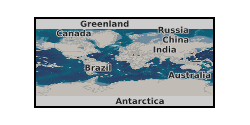Inertinite
Type of resources
Topics
Keywords
Contact for the resource
Provided by
Update frequencies
-

Supplementary material for published paper, Early Paleogene wildfires in peat-forming environments at Schoningen, Germany by BE Robson et al, http://doi.org/10.1016/j.palaeo.2015.07.016 NERC grant abstract: Human activity has led to an increase in pCO2 and methane levels from pre-industrial times to today. While the former increase is primarily due to fossil fuel burning, the increase in methane concentrations is more complex, reflecting not only direct human activity but also feedback mechanisms in the climate system related to temperature and hydrology-induced changes in methane emissions. To unravel these complex relationships, scientists are increasingly interrogating ancient climate systems. Similarly, one of the major challenges in palaeoclimate research is understanding the role of methane biogeochemistry in governing the climate of ice-free, high-pCO2 greenhouse worlds, such as during the early Paleogene (around 50Ma). The lack of proxies for methane concentrations is problematic, as methane emissions from wetlands are governed by precipitation and temperature, such that they could act as important positive or negative feedbacks on climate. In fact, the only estimates for past methane levels (pCH4) arise from our climate-biogeochemistry simulations wherein GCMs have driven the Sheffield dynamic vegetation model, from which methane fluxes have been derived. These suggest that Paleogene pCH4 could have been almost 6x modern pre-industrial levels, and such values would have had a radiative forcing effect nearly equivalent to a doubling of pCO2, an impact that could have been particularly dramatic during time intervals when CO2 levels were already much higher than today's. Thus, an improved understanding of Paleogene pCH4 is crucial to understanding both how biogeochemical processes operate on a warmer Earth and understanding the climate of this important interval in Earth history. We propose to improve, expand and interrogate those model results using improved soil biogeochemistry algorithms, conducting model sensitivity experiments and comparing our results to proxy records for methane cycling in ancient wetlands. The former will provide a better, process-orientated understanding of biogenic trace gas emissions, particularly the emissions of CH4, NOx and N2O. The sensitivity experiments will focus on varying pCO2 levels and manipulation of atmospheric parameters that dictate cloud formation; together, these experiments will constrain the uncertainty in our trace greenhouse gas estimates. To qualitatively test these models, we will quantify lipid biomarkers and determine their carbon isotopic compositions to estimate the size of past methanogenic and methanotrophic populations, and compare them to modern mires and Holocene peat. The final component of our project will be the determination of how these elevated methane (and other trace gas) concentrations served as a positive feedback on global warming. In combination our work will test the hypothesis that elevated pCO2, continental temperatures and precipitation during the Eocene greenhouse caused increased wetland GHG emissions and atmospheric concentrations with a significant feedback on climate, missing from most modelling studies to date. This work is crucial to our understanding of greenhouse climates but such an integrated approach is not being conducted anywhere else in the world; here, it is being led by international experts in organic geochemistry, climate, vegetation and atmospheric modelling, and palaeobotany and coal petrology. It will represent a major step forward in our understanding of ancient biogeochemical cycles as well as their potential response to future global warming.
 BGS Data Catalogue
BGS Data Catalogue